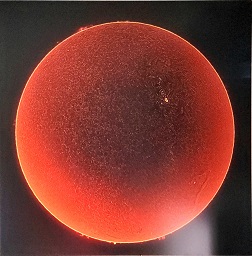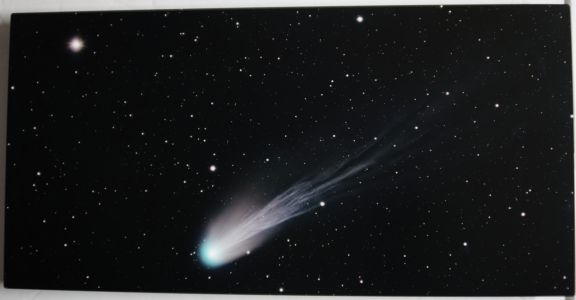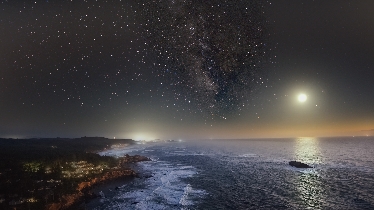Exhibition

Photography and Art by Jeremy Likness (DSW Galleries, LLC)
Jeremy Likness started astrophotography as a hobby in 2020. He quickly fell in love with photographing the night skies and began to invest in new equipment and try new techniques. After moving to Newport, Oregon, he grew an appreciation for outdoor and landscape photography in addition to astrophotography. Jeremy embraces several forms of astrophotography, including lunar, solar, deep sky, and Milky Way.
In Jeremy's own words:
"Each piece is part of a story and has been chosen to capture a moment so that it can be shared and experienced again. It's not just about the target, but the experience of acquiring the target. I've braved thunderstorms and black bears, dodged forest fires, hiked over glaciers and slept in the car when it was 19° Fahrenheit to get a shot. Sometimes I'll take 600 shots just to use 1."
Every piece comes with a certificate of authenticity and includes information including where and when the photograph was taken, how many prints exist or if it is an exclusive or first edition print, the settings and equipment used, a description of the target and any backstory around the photo itself.
If you are unable to find the piece you are looking for or it is not showing as available on this site, contact us with your request. Share the URL if available, the name of the target, and any preferences you may have for size or materials. Photographs on this page are of the actual artwork or piece.
Artwork from Jeremy Likness is on display at the following venues:
- DSW Galleries, LLC (contact for details) — from April 2024 to indefinitely at Newport, Oregon 97365

February 23, 2024 was an active day for our sun. In this image, the prominent sunspot on the lower left is AR3590. This mega-sunspot is larger than 9 earths and was a record for this 11-year solar cycle (Solar Cycle 25). Although AR3590 was known to produce one of the largest and strongest solar flares of cycle 25, in this photograph you can clearly see a filament streaming out of AR3591 in the upper left. Combined with the fine-detailed prominences dancing across the edge of the sun's disk, this high resolution print is strikingly detailed and simply stunning to observe on a 4-foot square frame of black metal.

The Devil's Comet earned its nickname due to cryovolcanic activity. Explosions of gases have been observed and one image gave it a distinct horned aspect. Comet 12P/Pons-Brooks is periodic, with an orbit every 71 years, making it a Halley-type comet. This year it was especially bright. I only had a few hours to image it after dusk, so I used a fast HyperStar system from the deck of some friends with an ocean view to avoid obstructions on the horizon. The comet is known for having an amazingly long and intricately detailed tail that I believe stands out in the metal print of this capture. It is in close proximity to bright star Hamal that glows like a diamond, hence: the Devil's diamond.

Taken from the Otter Crest Lookout on Cape Foulweather. From the vantage point several hundred meters above sea level, you can look out across the Pacific Ocean and down the Oregon Coast. I spent an evening there capturing images as the sun set and the bright crescent moon slid across the horizon to illuminate the water and the prominent outcrop known as 'Gull Rock.' I was able to capture the Milky Way despite its proximity to the moon. The buildings in the lower left are part of the Inn at Otter Crest. The first outcrop is a viewing area at the Inn at Otter Crest, and the more distant one is called the Devil's Punch Bowl. The glow you see on the horizon at the edge of the coast is the city of Newport. The glow farther inland is from the city of Toledo. The bright moon made processing interesting. I decided to use one exposure for the land and ocean details (1/45th second at ISO 400 taken earlier) and five 6-second exposures at ISO 4000 for the sky details. I stacked the longer exposures twice: once at full frame, then a second time cropped to just the stars and Milky Way to avoid the saturation caused by the moon. I stacked those together to produce the final result. This is a re-process of older data.

Orion is one of the most recognizable constellations with the signature red giant Betelgeuse for a shoulder and three bright, distinctive stars making up its belt. The leftmost star in the belt, Alnitak, hosts some of the most bright and beautiful nebulae in the night sky. These include the wispy Horsehead Nebula and fiery Flame Nebula. For this image, I took hours of exposures using narrowband filters for hydrogen alpha, oxygen, and sulfur. I then used an algorithm to remove the stars so I could focus on the intricate details the swirling gases and dust of the nebulae reveal. Finally, I printed the result directly on wood.




